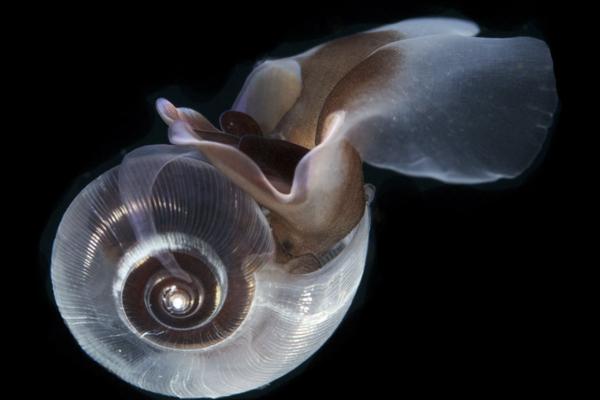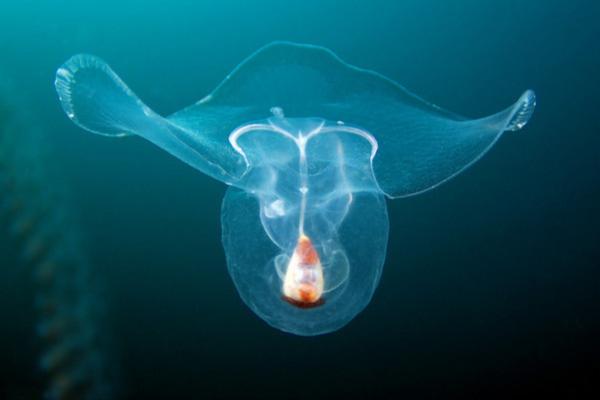Among the many marine mollusks that inhabit our oceans, most people are only familiar with common species like snails, oysters, or clams. However, there’s an entire group of lesser-known creatures that play crucial ecological roles — one of the most fascinating being the sea butterfly, scientifically known as Thecosomata. These tiny marine gastropods get their name from the way they appear to "fly" gracefully through water using wing-like appendages.
In this article, we’ll explore the morphological characteristics, natural habitat, feeding behavior, vertical migration patterns, and reproduction of sea butterflies, along with their significance in the oceanic food chain and global carbon cycle.

Sea butterflies are pelagic marine gastropods, closely related to sea snails. The scientific name Thecosomata refers to the presence of a thin, transparent shell made of aragonite — a form of calcium carbonate. Unlike the hard shells of land snails, these are fragile and often nearly invisible.
Varied shell shapes: Depending on the species, their shells may be spiral, conical, rounded, or even absent altogether.
Wing-like appendages: Known as parapodia, these are modified foot structures used for propulsion, creating a fluttering motion that resembles butterflies in flight.
Tiny body size: Ranging from just 10 mm to 10 cm in length.
Permanent suspension in water columns: Sea butterflies never touch the seafloor and live freely in open ocean water.
Fossil contribution: When they die, their shells sink to the seabed, serving as valuable bioindicators for reconstructing past oceanic conditions.
Ecological importance: Several species are among the most abundant pelagic gastropods in the world, contributing significantly to carbon cycling and forming a key part of the marine food web.
A notable example is Limacina helicina, an Arctic species that supports a wide range of predators such as seabirds, pink salmon (Oncorhynchus gorbuscha), seals, and even humpback whales (Megaptera novaeangliae).
Sea butterflies are widely distributed across all oceans and latitudes, from polar regions to tropical waters.
Most commonly found in warm, tropical seas, but some species thrive in cold polar environments.
Different species are adapted to specific temperature, salinity, and depth levels, making them excellent biological indicators of water quality.
They float in the upper layers of the ocean, usually within 0–25 meters of depth, where sunlight supports the growth of their primary food source—phytoplankton.
Sea butterflies are herbivorous plankton feeders, relying primarily on phytoplankton suspended in the water column.
They produce a spherical mucus web, which captures plankton particles as they float by.
Once the web is full, they draw it back into their bodies for digestion.
Some species actively chase their food, while others remain stationary and let prey come to them via their sticky mucus traps.
This highly efficient feeding technique makes them vital players in plankton regulation and primary production flow in marine ecosystems.

One of the most fascinating behaviors of sea butterflies is their daily vertical migration:
During the day: They descend to deeper, darker waters to avoid predators.
At night: They rise toward the surface to feed safely under cover of darkness.
This diel vertical migration is common among pelagic marine species and helps balance feeding efficiency with predator avoidance.
Adult sea butterflies reproduce by producing egg masses containing up to 200 fertilized eggs.
First cell divisions occur within 15 minutes after fertilization.
After 28 hours, the embryo develops into a trochophore larva with a primitive shell.
It then transitions into a veliger larva, or secondary larval stage, also bearing a shell.
Most adult sea butterflies retain a shell, although some genera like Desmopterus are shell-less or possess a pseudoconch (soft shell-like structure).
Maturity is reached once the reproductive organs are fully developed and functional.

Sea butterflies are not only beautiful but also ecologically critical. They:
Serve as a key food source for commercially valuable fish, whales, penguins, and polar bears.
Contribute significantly to ocean carbon cycling through the sinking of their calcium-rich shells.
Act as sensitive bioindicators of environmental change, particularly ocean acidification, which threatens their fragile aragonite shells.
Protecting sea butterflies means safeguarding entire marine food chains and ocean health.
Though small and delicate, sea butterflies play a major role in maintaining the balance of marine ecosystems. Their unique biology, wide distribution, and sensitivity to environmental change make them essential subjects for oceanographic research and climate monitoring.
Bibliography
Gasca R. (2011). Computerization of Pteropods (Thecosomata: Gastropoda) from the Caribbean of Mexico and Belize. El Colegio de la Frontera Sur, Chetumal Unit. Final Report SNIB-CONABIO Project No. HC007. Mexico City.
Labrín, M., Guzmán, G., & Sielfeld, W. (2015). Thecosomate pteropods in the southeastern Pacific off Caldera, Chile (Mollusca, Opistobranchiata: Euthecostomata and Pseudothecostomata). Latin American Journal of Aquatic Research, 43(1), 71-79.
Wakabayashi, K. (2017). Embryonic development of the sea butterfly Desmopterus papilio (Gastropoda: Thecosomata). Invertebrate Reproduction & Development, 61(3), 142-146.
animal tags: Sea Butterflies
We created this article in conjunction with AI technology, then made sure it was fact-checked and edited by a Animals Top editor.